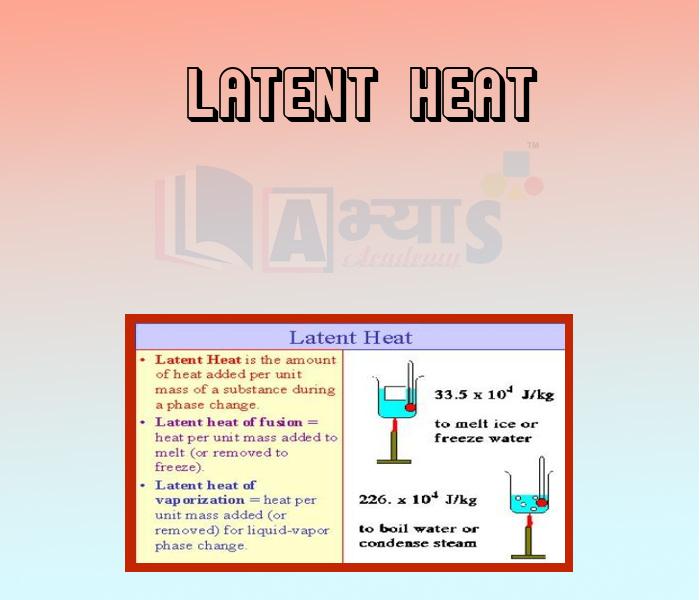Latent Heat










Latent Heat
Latent Heat Of Vaporisation:
The latent heat of vaporisation of a substance is defined as the quantity of heat gained by 1 kg of the substance in changing from liquid to vapour state or from vapour to liquid state at constant temperature.
When you heat a liquid, its molecules start moving faster and gain kinetic energy. This shows as a rise in its temperature. At the boiling point, however, the heat supplied is used by the molecules to break away from the inter-molecular force and change into vapour molecules, rather than to move faster.This is why there is no change in the temperature. The heat required to help the molecules of liquid to overcome the inter-molecular forces and to escape as a vapour molecules is known as the latent heat of vaporisation.
Latent Heat Of Fusion:
The latent heat of fusion is defined as the quantity of heat gained by 1 kg of substance in changing from the solid to liquid at same temperature.
When a solid is heated, its molecules start vibrating faster and its temperature rises until it reaches the melting point. Then the temperature remains constant until the entire solid changes to liquid. The heat supplied during the process is used by the molecules to overcome the inter-molecular force, and not to raise the temperature.This heat is called the latent heat of fusion. It is gained by the solid molecules to change to liquid molecules at constant temperature.
In the reverse process, liquid molecules lose the latent heat of fusion to change to solid molecules at the freezing point. During this process too the temperature remains constant.
The latent heat of fusion is gained by the solid molecules to change to _____________________ molecules at constant temperature. | |||
| Right Option : B | |||
| View Explanation | |||
Which of the following are correct ? (a) The latent heat of fusion is defined as the quantity of heat gained by 1 kg of substance in changing from the liquid to solid at same temperature. (b) The latent heat supplied during the process is used by the molecules to overcome the intermolecular force, and not to raise the temperature. | |||
| Right Option : B | |||
| View Explanation | |||
Which of the following are correct ? (a) The latent heat of fusion is defined as the quantity of heat gained by 1 kg of substance in changing from the solid to liquid . (b) The latent heat of vaporisation of a substance is defined as the quantity of heat gained by 1 kg of the substance in changing from vapour to liquid state . (c) The liquid molecules lose the latent heat of fusion to change to solid molecules at the freezing point. | |||
| Right Option : C | |||
| View Explanation | |||
Students / Parents Reviews [10]
Being a parent, I saw my daughter improvement in her studies by seeing a good result in all day to day compititive exam TMO, NSO, IEO etc and as well as studies. I have got a fruitful result from my daughter.

Prisha Gupta
8thOne of the best institutes to develope a child interest in studies.Provides SST and English knowledge also unlike other institutes. Teachers are co operative and friendly online tests andPPT develope practical knowledge also.

Aman Kumar Shrivastava
10thA marvelous experience with Abhyas. I am glad to share that my ward has achieved more than enough at the Ambala ABHYAS centre. Years have passed on and more and more he has gained. May the centre flourish and develop day by day by the grace of God.

Archit Segal
7thIt has a great methodology. Students here can get analysis to their test quickly.We can learn easily through PPTs and the testing methods are good. We know that where we have to practice

Barkha Arora
10thAbout Abhyas metholodology the teachers are very nice and hardworking toward students.The Centre Head Mrs Anu Sethi is also a brilliant teacher.Abhyas has taught me how to overcome problems and has always taken my doubts and suppoeted me.

Shreya Shrivastava
8thI have spent a wonderful time in Abhyas academy. It has made my reasoning more apt, English more stronger and Maths an interesting subject for me. It has given me a habbit of self studying

Yatharthi Sharma
10thIt was a good experience with Abhyas Academy. I even faced problems in starting but slowly and steadily overcomed. Especially reasoning classes helped me a lot.

Cheshta
10thAbhyas is a complete education Institute. Here extreme care is taken by teacher with the help of regular exam. Extra classes also conducted by the institute, if the student is weak.

Om Umang
10thAbhyas Methodology is very good. It is based on according to student and each child manages accordingly to its properly. Methodology has improved the abilities of students to shine them in future.

Manish Kumar
10thMy experience was very good with Abhyas academy. I am studying here from 6th class and I am satisfied by its results in my life. I improved a lot here ahead of school syllabus.
